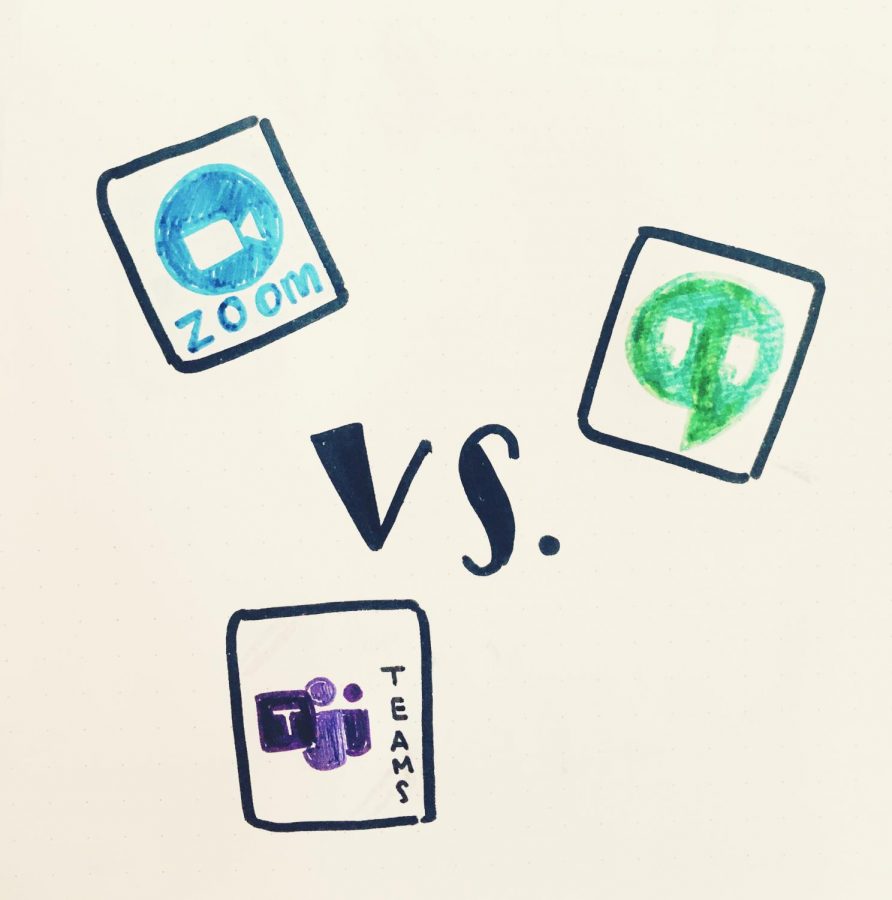Video Conferencing Platforms Reviewed
photo courtesy of sofia Guerra
With all the video conferencing software out there, which is the right one for you?
May 1, 2020
Connecting and learning online has become essential during the COVID-19 pandemic and campus closures, and with that the necessity for a robust video conferencing platform. There are many services available, including Zoom, Microsoft Teams and Google Hangouts. So which is the best?
Pricing
Probably one of the most important pieces of information for most schools is pricing. Because schools can have upwards of thousands of students, pricing can be very important. Zoom is interesting in this matter. Your basic plan comes with unlimited meetings. However, these meetings have a 40 minute limit, something that can be very restrictive. In addition, this plan is only for one host. On the other hand, schools with upwards of 100 teachers would require the most expensive plan, which could amount to $2,000 per month. Microsoft Teams is also expensive, but Microsoft is now allowing schools to have Office 365 for free. Microsoft Teams is included in that bundle, so Teams is free. This can be a huge selling point for schools that may not have the resources to pay $2,000 per month for a service. Finally, Google Hangouts. Although Google Hangouts is free, Google charges for storage, so 30GB of storage costs $5. Although this may not seem important, for schools looking into moving all online classrooms onto Google, storage is key. And storage prices only rise from there. In this category, my winner is Microsoft Teams.
Security
Recently Zoom has been under backlash for security reasons. Some of those have to do with “Zoom Hackers.” Zoom hackers will enter the Zoom network and steal hundreds of passcodes each time. Estimates have shown that hackers have stolen over 500,000 student accounts. Hackers have also been known to enter “private” Zoom meetings and sit in on whatever is happening. According to one New York Post article, a New Jersey school district has stopped using Zoom for distance learning after a hacker entered a meeting and streamed adult content into the classroom. Microsoft Teams on the other hand is quite the opposite. The only bug they seem to have met is a bug which relates to GIFs. These GIFs will allow hackers entrance to someone’s account, and they can later enter the account via temporary access codes. However, according to other sources the bug, if not fixed already, is being worked on. Otherwise, Microsoft Teams is part of the Microsoft Suite, a very common tool used in everyday work, one which has not faced very many security concerns recently. Google Hangouts has faced some long term security backlash. According to security sources, Google Hangouts uses in-transit encryption. This means that when you send something, or while your call happens, it is being encrypted while it transmits. While this is a good type of encryption, it isn’t the best, as it offers a short window for hackers to enter. The most secure common form of encryption is end to end, which involves encryption while the message is being sent, while it is sending, and while it is being received.
Overall View
Finally, the last category, the overall view of the platform. Zoom offers a strong platform, with many superior features. Zoom gives the added bonus of being able to see multiple people. During a Zoom call, the attendants can view up to 49 people on the same screen. Other than that, Zoom offers many base features including a chat, the ability to share your screen, and viewing participants. Microsoft Teams falls a bit short in this category. Although it shares some of the same base features, it lacks on the faces category. During a Microsoft Teams call, you can only view up to four people at one time. Although Microsoft has made it clear it plans to upgrade that to nine people, the date for that release is still unclear, and these claims have been going on for years. Otherwise, one part in which Teams prevail, is look and feel. Hangouts and Zoom offer somewhat professional looks, and Teams offers the best one by far, with a slick and excellent presentation. Finally, Hangouts offers, once again, a somewhat sub-par experience. Although you can access a chat, and share your screen, unlike Zoom and Teams, there are no background options, and advanced features are non-existent. During a call, you can see up to ten people, but as I said, there is not much else you can do.
Final Thoughts
Overall, my winner is Microsoft Teams. It offers affordable, professional, and reliable software. Although it may be lacking in some categories, it more than makes up for it in others. Although Hangouts is an option, the next best thing is Zoom.










